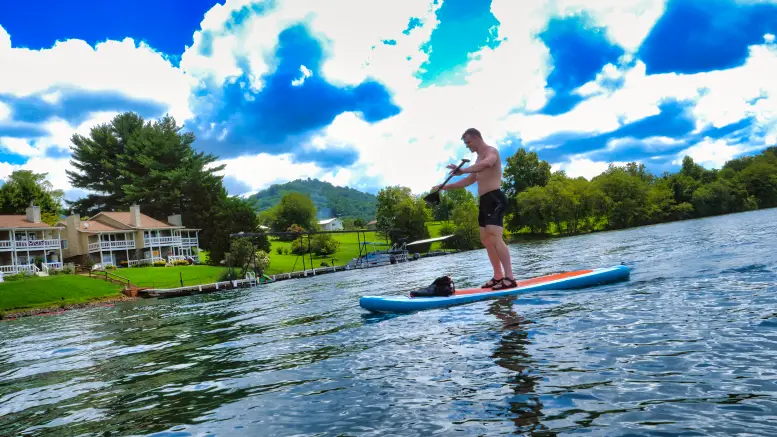I was at Allatoona Lake in Georgia when a random guy asked to use my paddleboard. It was his first time and he took it out for 5 minutes and had the time of his life. While watching from the shore, I asked his friend if he wanted to take it for a spin, and it broke my heart to hear that he wants to, but scared because he can’t swim.
So is it true that you can’t Paddleboard if you can’t swim?
While the likely hood of falling into the water on a standup paddleboard is much more likely than kayaking, the answer isn’t black or white. It’s a bit nuanced and depends on a few factors that we’ll cover below. But if you’re adamant about paddleboarding but can’t swim, there are 6 tips below I highly recommend you do.
6 Paddle Boarding Tips If You Can’t Swim & Alone
1. Life Jacket & SUP Ankle Leash
You 100% absolutely need a life jacket on a paddle board without question. Losing your balance and falling into the water is extremely high. The questions you need to ask yourself are; How well can you stay afloat with a life jacket? How comfortable do you feel in deep water with a life jacket?
Also, if your paddleboard has one, you also need to wear the paddleboard ankle leash in case you fall, the board won’t get away from you. Now, if you don’t feel comfortable in deep water with only a life jacket, that determines how close to shore you need to be. This brings us to the next tip.
2. Stay Relatively Close To Shore
Depending on how far from shore you go depends on how comfortable you feel swimming in deep water with only a life jacket. Because for a lot of us, the question isn’t if you’re going to fall into the water from an SUP, but when. I personally recommend you to stay close where it’s shallow enough for your feet to touch.
3. Find Still Water
Rivers, lakes, and especially the ocean with a lot of choppy water increases the likely hood of falling off the SUP. Regardless of how secure your life jacket is, the goal is to prevent you from falling off the board. Which leads to the next tip.
4. Rather Than Standing, Kneel Or Sit
Including myself, most people fall into the water from losing balance while standing. Sometimes it’s caused by waves, choppy water, getting tired, or just randomly losing balance from being human.
While kneeling or sitting on a paddle board isn’t as fun as standing, it’s still a lot of fun. And safety always comes first. So if you can’t swim and aren’t sure if the water below you is shallow enough to stand, I recommend kneeling or sitting down.
However, if you enjoy standing, it will be best to kneel down if you encounter boat waves.
5. Bring An Emergency Whistle
I think everyone needs to bring an emergency whistle. Not only would you need it in case of an emergency, but also to warn boats or jet skis that are getting too close and don’t see you. I highly recommend the LuxoGear whistle since it’s made for survival, watersports, etc. It’s incredibly loud getting up to 120 decibels. It’s best to tie it on your life vest.
6. What To Do If You Fall Off
Luckily, if you followed the previous steps, you’re close to shore and you have your life jacket on. But if you’re in deep water and you fall off your SUP paddle board, here’s what you should do.
- Grab the paddleboard, find the center handle, and hold it tightly. Both the board and life vest should keep you afloat without issues.
- Kick your legs as hard and quick as you can while pulling the center handle with one hand and holding the far side of the board with your other hand. This will bring the paddleboard towards you while your body’s forward motion should get you back on the SUP. Do this while trying to keep the board from flipping by using your arm to grab the rim to keep the board down.
- Realine your legs with the paddle board bringing them out of the water.
- Use your hands to swim to the paddle that’s somewhere in the water. And go about your day.
- If Climbing on the side doesn’t work, climb up from the back of the board. (If your board allows the tail to go below the water, it ussually works..
If you can’t swim, I actually recommend practicing this first in shallow water or a pool so you’ll know what to do.
In case you aren’t able to pull yourself up on the SUP, hold on to the handle and use it as a floating device where you kick your way to shore. And if you feel the need, blow the emergency whistle for help. But if you stay close to shore like the 2nd tip, most of this will most likely not be an issue since you’ll either be able to stand in the water, or the shore will be easily close enough to kick your way towards.

Summary | Can You Paddle Board If You Can’t Swim?
At the end of the day, the real question is, did you have fun or was it more stressful than anything? If you find that paddleboarding is too stressful due to worry from falling off, you might be better off with a kayak since you’re less likely to fall off. That’s only if you’re adament on watersports. Other than that, I hope this article helped. Thank you so much for reading!
If you’re looking for over-ear headphones, see our top picks here.
See the top made-in-USA sunglasses here.
Need a modern outdoor coffee table? See the top picks here.
Need an alarm clock? See the top choices here.


